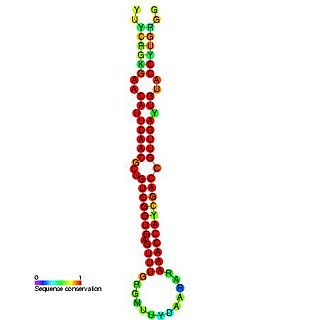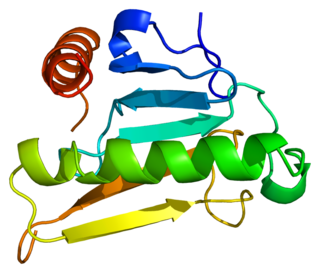Related Research Articles

A non-coding RNA (ncRNA) is a functional RNA molecule that is not translated into a protein. The DNA sequence from which a functional non-coding RNA is transcribed is often called an RNA gene. Abundant and functionally important types of non-coding RNAs include transfer RNAs (tRNAs) and ribosomal RNAs (rRNAs), as well as small RNAs such as microRNAs, siRNAs, piRNAs, snoRNAs, snRNAs, exRNAs, scaRNAs and the long ncRNAs such as Xist and HOTAIR.

Pseudogenes are nonfunctional segments of DNA that resemble functional genes. Most arise as superfluous copies of functional genes, either directly by gene duplication or indirectly by reverse transcription of an mRNA transcript. Pseudogenes are usually identified when genome sequence analysis finds gene-like sequences that lack regulatory sequences needed for transcription or translation, or whose coding sequences are obviously defective due to frameshifts or premature stop codons. Pseudogenes are a type of junk DNA.

Hepatocellular carcinoma (HCC) is the most common type of primary liver cancer in adults and is currently the most common cause of death in people with cirrhosis. HCC is the third leading cause of cancer-related deaths worldwide.

In evolutionary biology, conserved sequences are identical or similar sequences in nucleic acids or proteins across species, or within a genome, or between donor and receptor taxa. Conservation indicates that a sequence has been maintained by natural selection.

T-box transcription factor T, also known as Brachyury protein, is encoded for in humans by the TBXT gene. Brachyury functions as a transcription factor within the T-box family of genes. Brachyury homologs have been found in all bilaterian animals that have been screened, as well as the freshwater cnidarian Hydra.

In molecular biology miR-181 microRNA precursor is a small non-coding RNA molecule. MicroRNAs (miRNAs) are transcribed as ~70 nucleotide precursors and subsequently processed by the RNase-III type enzyme Dicer to give a ~22 nucleotide mature product. In this case the mature sequence comes from the 5' arm of the precursor. They target and modulate protein expression by inhibiting translation and / or inducing degradation of target messenger RNAs. This new class of genes has recently been shown to play a central role in malignant transformation. miRNA are downregulated in many tumors and thus appear to function as tumor suppressor genes. The mature products miR-181a, miR-181b, miR-181c or miR-181d are thought to have regulatory roles at posttranscriptional level, through complementarity to target mRNAs. miR-181 has been predicted or experimentally confirmed in a wide number of vertebrate species such as rat, zebrafish, and pufferfish.

Bis(5'-adenosyl)-triphosphatase also known as fragile histidine triad protein (FHIT) is an enzyme that in humans is encoded by the FHIT gene.

Poly(rC)-binding protein 2 is a protein that in humans is encoded by the PCBP2 gene.

WW domain-containing oxidoreductase is an enzyme that in humans is encoded by the WWOX gene.

Glypican-3 is a protein that, in humans, is encoded by the GPC3 gene. The GPC3 gene is located on human X chromosome (Xq26) where the most common gene encodes a 70-kDa core protein with 580 amino acids. Three variants have been detected that encode alternatively spliced forms termed Isoforms 1 (NP_001158089), Isoform 3 (NP_001158090) and Isoform 4 (NP_001158091).

Epithelial membrane protein 3 (EMP3) is a trans-membrane signaling molecule that is encoded by the myelin-related gene EMP3. EMP3 is a member of the peripheral myelin protein gene family 22-kDa (PMP22), which is mainly responsible for the formation of the sheath of compact myelin. Although the detailed functions and mechanisms of EMP3 still remain unclear, it is suggested that EMP3 is possibly epigenetically linked to certain carcinomas.

Long non-coding RNAs are a type of RNA, generally defined as transcripts more than 200 nucleotides that are not translated into protein. This arbitrary limit distinguishes long ncRNAs from small non-coding RNAs, such as microRNAs (miRNAs), small interfering RNAs (siRNAs), Piwi-interacting RNAs (piRNAs), small nucleolar RNAs (snoRNAs), and other short RNAs. Given that some lncRNAs have been reported to have the potential to encode small proteins or micro-peptides, the latest definition of lncRNA is a class of RNA molecules of over 200 nucleotides that have no or limited coding capacity. Long intervening/intergenic noncoding RNAs (lincRNAs) are sequences of lncRNA which do not overlap protein-coding genes.

miR-122 is a miRNA that is conserved among vertebrate species. miR-122 is not present in invertebrates, and no close paralogs of miR-122 have been detected. miR-122 is highly expressed in the liver, where it has been implicated as a regulator of fatty-acid metabolism in mouse studies. Reduced miR-122 levels are associated with hepatocellular carcinoma. miR-122 also plays an important positive role in the regulation of hepatitis C virus replication.

Homeobox protein DBX2, also known as developing brain homeobox protein 2, is a protein that in humans is encoded by the DBX2 gene. DBX2 plays an important role in the development of the central nervous system, specifically in the development of the neural tube and brain. DBX2 is located on chromosome 12 and is approximately 36,000 base pairs long. DBX2 is predicted to enable DNA-binding transcription activity as well as being involved in the regulation of transcription by RNA polymerase II.

In molecular biology miR-203 is a short non-coding RNA molecule. MicroRNAs function to regulate the expression levels of other genes by several mechanisms, such as translational repression and Argonaute-catalyzed messenger RNA cleavage. miR-203 has been identified as a skin-specific microRNA, and it forms an expression gradient that defines the boundary between proliferative epidermal basal progenitors and terminally differentiating suprabasal cells. It has also been found upregulated in psoriasis and differentially expressed in some types of cancer.
UCbase is a database of ultraconserved sequences that were first described by Bejerano, G. et al. in 2004. They are highly conserved genome regions that share 100% identity among human, mouse and rat. UCRs are 481 sequences longer than 200 bases. They are frequently located at genomic regions involved in cancer, differentially expressed in human leukemias and carcinomas and in some instances regulated by microRNAs. The first release of UCbase was published by Taccioli, C. et al. in 2009. Recent updates include new annotation based on hg19 Human genome, information about disorders related to the chromosome coordinates using the SNOMED CT classification, a query tool to search for SNPs, and a new text box to directly interrogate the database using a MySQL interface. Moreover, a sequence comparison tool allows the researchers to match selected sequences against ultraconserved elements located in genomic regions involved in specific disorders. To facilitate the interactive, visual interpretation of UCR chromosomal coordinates, the authors have implemented the graph visualization feature of UCbase creating a link to the UCSC Genome Browser. UCbase 2.0 does not provide microRNAs (miRNAs) information anymore focusing only on UCRs. The official release of UCbase 2.0 was published in 2014.
A conserved non-coding sequence (CNS) is a DNA sequence of noncoding DNA that is evolutionarily conserved. These sequences are of interest for their potential to regulate gene production.
An ultra-conserved element (UCE) was originally defined as a genome segment longer than 200 base pairs (bp) that is absolutely conserved, with no insertions or deletions and 100% identity, between orthologous regions of the human, rat, and mouse genomes. 481 ultra-conserved elements have been identified in the human genome. If ribosomal DNA are excluded, these range in size from 200 bp to 781 bp. UCRs are found on all chromosomes except for 21 and Y. A database collecting genomic information about ultra-conserved elements (UCbase) is available at http://ucbase.unimore.it.

ABHD18 is a protein that in Homo sapiens is encoded by the ABHD18 gene.

Transmembrane protein 82 (TMEM82) is a protein encoded by the TMEM82 gene in humans.
References
- ↑ Calin GA, Liu CG, Ferracin M, Hyslop T, Spizzo R, Sevignani C, Fabbri M, Cimmino A, Lee EJ, Wojcik SE, Shimizu M, Tili E, Rossi S, Taccioli C, Pichiorri F, Liu X, Zupo S, Herlea V, Gramantieri L, Lanza G, Alder H, Rassenti L, Volinia S, Schmittgen TD, Kipps TJ, Negrini M, Croce CM (September 2007). "Ultraconserved regions encoding ncRNAs are altered in human leukemias and carcinomas". Cancer Cell. 12 (3): 215–229. doi: 10.1016/j.ccr.2007.07.027 . PMID 17785203.
- ↑ Bejerano G, Lowe CB, Ahituv N, King B, Siepel A, Salama SR, Rubin EM, Kent WJ, Haussler D (May 2006). "A distal enhancer and an ultraconserved exon are derived from a novel retroposon". Nature. 441 (7089): 87–90. Bibcode:2006Natur.441...87B. doi:10.1038/nature04696. PMID 16625209. S2CID 4387930.
- ↑ Bejerano G, Pheasant M, Makunin I, Stephen S, Kent WJ, Mattick JS, Haussler D (May 2004). "Ultraconserved elements in the human genome". Science. 304 (5675): 1321–1325. Bibcode:2004Sci...304.1321B. CiteSeerX 10.1.1.380.9305 . doi:10.1126/science.1098119. PMID 15131266. S2CID 2790337.
- 1 2 3 4 Braconi C, Valeri N, Kogure T, Gasparini P, Huang N, Nuovo GJ, Terracciano L, Croce CM, Patel T (January 2011). "Expression and functional role of a transcribed noncoding RNA with an ultraconserved element in hepatocellular carcinoma". Proceedings of the National Academy of Sciences of the United States of America. 108 (2): 786–791. Bibcode:2011PNAS..108..786B. doi: 10.1073/pnas.1011098108 . PMC 3021052 . PMID 21187392.
- ↑ Czyzyk-Krzeska MF, Bendixen AC (March 1999). "Identification of the poly(C) binding protein in the complex associated with the 3′ untranslated region of erythropoietin messenger RNA". Blood. 93 (6): 2111–2120. doi:10.1182/blood.V93.6.2111.406k24_2111_2120. PMID 10068686.